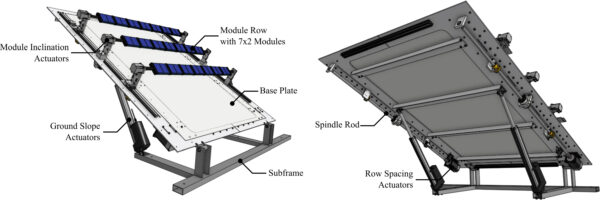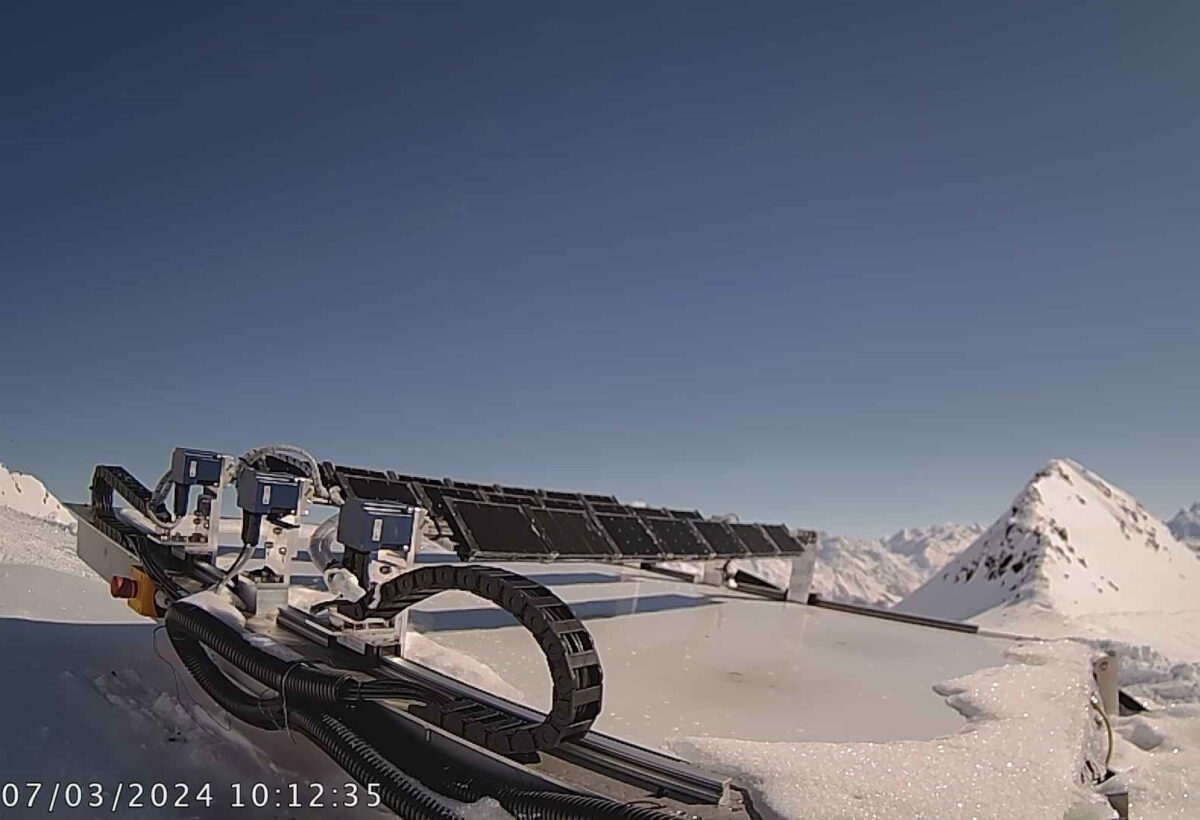Scientists from ZHAW Zurich University of Applied Sciences have tested a miniature of a fully automatic multi-row high-alpine PV array. The miniature was designed as a 1:12 scale of an alpine PV field and was installed at an altitude of around 2,500 m in Davos, Switzerland. It consisted of three rows of seven back-to-back monofacial panels, virtually mimicking bifacial modules.
“High-alpine installations are not commonplace nowadays, and as such, there is not much real-world experience in planning and optimizing the field layouts. Yield calculations in steep terrain, in combination with a highly reflective snow cover, are particularly complex,” corresponding author Michael Wild told pv magazine. “We were able to show that an industry-standard software is capable of performing these calculations to a satisfying degree, although there are a number of factors that have to be paid special attention to, such as the albedo of snow. This should raise confidence in simulation results, which hopefully in turn raises investor confidence.”
The glass-glass PV modules were tailor-made and consisted of three individual interdigitated back-contact (IBC) cells, with dimensions of 90 mm × 43.3 mm each and a maximum power of 2.6 W. Each module row consisted of a carbon fiber rod, onto which the modules were fastened. The whole assembly is fixed to the roof of the shipping container housing the electrical equipment. To keep albedo levels under control, a white aluminum sheet was placed under the modules with an albedo of 0.798, corresponding to fresh snow. Silicon heaters were placed underneath to stop the accumulation of snow and ice.
Different motors were able to change the positions of the modules. The whole array was able to change its ground slope from a minimum of 0◦ to a maximum of 40◦; the spacing between the rows was changing between 115 mm to 700 mm, and the inclination of the modules themselves was set in the rage of −40◦ to 90◦. Overall, 80 combinations of positions were tested, focusing on the middle modules of the southern and northern rods.
The testing was carried out from October 2023 to March 2024, with the results from December and January being omitted due to technical errors. To validate the miniature system, the team compared it to a full-size PV system located at the same testing site. It comprises six groups of three to four modules, with mono- and bifacial groups at module inclinations of 40◦, 60◦, and 90◦.

Image: ZHAW Zurich University of Applied Sciences, Solar Energy, CC BY 4.0
“In general, the measurements of both systems are in remarkably good agreement with each other,” the team highlighted. “For the monofacial comparison, deviations of less than 1% were observed in November and February, 3.9% in March, and 14.2% in October. The comparisons of bifacial measurements were slightly more variable but still remarkably close, given the differences in system design.”
One of the reasons for deploying that miniature setup is to compare their field measurements with those of the commercial software PVsyst, equipped with the Meteonorm albedo settings that correspond to the guidelines set out by the Swiss Federal Office for Energy. Those were set for the “Solarexpress” subsidy scheme, which is planned to support alpine PV projects.
“In order to obtain the lucrative subsidy for alpine PV projects in Switzerland, a plant must produce over 10 GWh annually, and reach a specific yield of 500 kWh/kWp during the winter months of October-March,” the academics said. “The scale of investment necessitates a high level of confidence in yield simulations. While commercial software is available, the accuracy of simulation results is not necessarily given.”
Per the comparison of the experimental results and the simulation, the albedo values of Meteonorm are too low, resulting in an estimated yield of 7%-16% lower. “Further it was shown that using a shading-angle equivalent projected system for arrays on sloped surfaces leads to a systematic error, itself depending on the respective module inclinations,” they highlighted, noting that the underestimation of the energy yield depends on the increased albedo in snow-covered surrounding.”
The findings were presented in “Comparing measurements and simulations using an adjustable high-alpine photovoltaic array,” published in Solar Energy. “It was honestly surprising to see how well the simulations match what we measure in reality over a wide range of parameters – given all the simplifications and idealizations, that was not clear from the beginning. This also encourages us to widen the scope of PV fields we look at, e.g. non-southern orientations,” Wild added.
This content is protected by copyright and may not be reused. If you want to cooperate with us and would like to reuse some of our content, please contact: editors@pv-magazine.com.



By submitting this form you agree to pv magazine using your data for the purposes of publishing your comment.
Your personal data will only be disclosed or otherwise transmitted to third parties for the purposes of spam filtering or if this is necessary for technical maintenance of the website. Any other transfer to third parties will not take place unless this is justified on the basis of applicable data protection regulations or if pv magazine is legally obliged to do so.
You may revoke this consent at any time with effect for the future, in which case your personal data will be deleted immediately. Otherwise, your data will be deleted if pv magazine has processed your request or the purpose of data storage is fulfilled.
Further information on data privacy can be found in our Data Protection Policy.